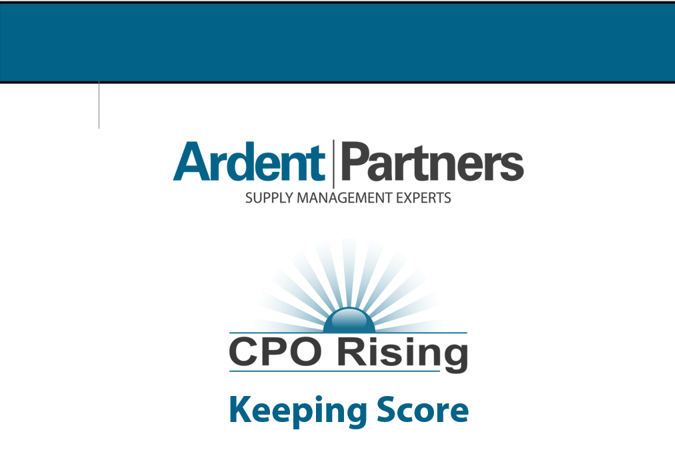Over the past few Thursdays, I have been highlighting the 15 annual CPO/State of Procurement reports that I have written. In November 2012, we published CPO Rising 2012: Keeping Score a report that looked at procurement performance measurement and the strategies that different CPOs and enterprises use to score it. After all, even today, scoring procurement performance can be as complex and nuanced as the value that the function delivers; linking that performance to overall business objectives and results can be even more difficult. Nonetheless, it is incumbent upon CPOs to “keep score” of their team’s performance and use that opportunity to develop a set of metrics that can help procurement departments prioritize and focus their resources, track and improve their performance, and communicate how their work and results support enterprise objectives and what they plan to achieve in the future. This is the report that introduced the CPO Scorecard™ that many procurement departments used to de-emphasize the importance of savings and present a more balanced way to evaluate a procurement operation.
Here are a few excerpts:
Businesses measure their revenues and profits for a reason – because they matter. These numbers matter to employees, they matter to owners and shareholders, and they matter to customers and suppliers. The bottom line numbers that get reported are a final “score” for a “game” that was played last quarter or last year. And, businesses, by and large, are playing that game to win. If they were not, they would not keep score. For Chief Procurement Officers (“CPOs”) and their departments, procurement results matter and they increasingly matter to the larger enterprise. Scoring procurement performance can be as complex and nuanced as the value that the function can deliver and linking that performance to overall business objectives and results can be even more difficult. Nonetheless, CPOs must keep score of their team’s performance and they should use the opportunity to develop a set of metrics that can help procurement prioritize and focus its resources, track and improve its performance, and help communicate the value that it delivers in support of enterprise objectives and what it plans to achieve in the future.
In 2012, the good news for many Chief Procurement Officers (“CPOs”) and their staffs is that they have a secure place on their enterprise’s “varsity” team; for most, it is a position that was rightly earned. The deep and sudden shock that the 2008-2009 financial crisis had on business performance served as a wake-up call to all enterprises, but, particularly to those that were caught flat-footed and without flexibility in their cost structures and supply chains. The CPOs, who were able to respond to the market shift and execute amidst global turmoil and general uncertainty, gave their executives (and ultimately, themselves) a big lift. And, while much has been made of the significant role that procurement played during the tough times, the CPOs who were able to quickly pivot their operations and manage growth when the market rebounded strongly were no less important.
In 2012, the average CPO’s managerial sophistication continues to advance with the vast majority of CPOs creating and using a strategic plan to manage their departments; the same could not be said five years ago. K. Venkat Krishnan, Sourcing Leader at GE Energy said that, “We use a three-year plan and a one-year plan to drive our strategy. We recalibrate our one-year plan three times a year.” With nearly one in five CPOs reporting to either the CEO or President of their company, the likelihood that the CPO’s agenda would be tightly-linked to the CEO’s strategic plan seems high. Sometimes that is the case, as with the CPO of an Indian-based Pharmaceutical company who said “Our new CEO is in the process of rolling out a new strategic plan and procurement will be a big part of it.” Unfortunately, Ardent Partners’ research indicates (see Figure 2 below) that just slightly more than one in five CPOs is working on a plan that is well aligned with the enterprise’s top goals and objectives. So, while it has greatly improved in recent years, the CPO’s coordination and alignment with the CEO is also a work in progress.
That the average procurement department still struggles with some aspects of its operations and does not always manage to efficiently and effectively deliver value is not ideal; but, in a broader review of other enterprise functions, procurement’s performance is not so unique.
Procurement and finance should work to develop and implement a CPO Scorecard™ to measure procurement’s performance. Finance and procurement leaders must begin to consider, discuss, and develop a more sophisticated and comprehensive way to evaluate and present procurement’s performance to the larger enterprise. If procurement’s transformation is to continue, a more balanced approach to measuring its performance is needed.
RELATED RESEARCH
Two Great NEW Webinars
NEW – The Procurement Metrics that Matter in 2020 Webinar
NEW – User-Friendly, User-Powerful: The New Consumerization of Procurement
Two Great CLASSIC Reports
CLASSIC – CPO Rising 2011: Innovative Ideas for the Decade Ahead
CLASSIC – The CPO’s Agenda 2009: Smart Strategies for Tough Times

